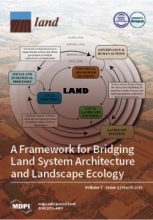/ library resources
Showing items 3817 through 3825 of 73534.Inclusive businesses (IBs), embodying partnerships between commercial agribusinesses and smallholder farmers/low-income communities, are considered to contribute towards rural development and agricultural sector transformation.
Recently, droughts have become widespread in the Northern Hemisphere, including in Mongolia. The ground surface condition, particularly vegetation coverage, affects the occurrence of dust storms.
The concept of landscape has been increasingly used, in the last decades, in policy and land use planning, both in regard to so-called “special” and to “ordinary” or “everyday” landscapes.
The sustainable management of natural resources, and particularly groundwater, presents a major challenge in arid regions to ensure security of water supply and support agricultural production.
Since the early 20th century, “desert reclamation” has been synonymous with large-scale waterworks and irrigation. These techniques have made it possible to produce abundant crops in arid or semi-arid environments.
Common approaches to mapping green infrastructure in urbanised landscapes invariably focus on measures of land use or land cover and associated functional or physical traits.
This study examines the effects of different grazing systems in two neighboring regions with similar biotic and abiotic factors, Nalan Soum in Mongolia and Naren Soum in Inner Mongolia, China.
Accounting for one quarter of China’s land area, the endorheic Shiyang River basin is a vast semi-arid to arid region in China’s northwest. Exploring the impact of changes in land use on this arid area’s carbon budget under global warming is a key component to global climate change research.
Kenya is the most recent African state to acknowledge customary tenure as producing lawful property rights, not merely rights of occupation and use on government or public lands. This paper researches this new legal environment.
Pagination
Land Library Search
Through our robust search engine, you can search for any item of the over 64,800 highly curated resources in the Land Library.
If you would like to find an overview of what is possible, feel free to peruse the Search Guide.

